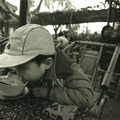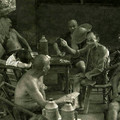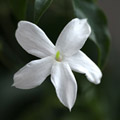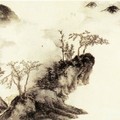Japanese green tea
„Green tea (緑茶 Ryokucha) is ubiquitous in Japan and therefore is more commonly known simply as "tea" (お茶 ocha).“
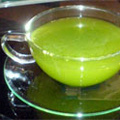
„Sencha (煎茶, decocted tea) - The first and second flush of green tea made from leaves that are exposed directly to sunlight. This is the most common green tea in Japan. The name describes the method for preparing the beverage.“

„Gyokuro (玉露, Jade Dew) - Gyokuro is a fine and expensive type that differs from Sencha (煎茶) in that it is grown under the shade rather than the full sun for approximately 20 days. The name "Gyokuro" translates as "jade dew" and refers to the pale green color of the infusion. The shading causes the amino acids (Theanine) and caffeine in the tea leaves to increase, while catechins (the source of bitterness in tea, along with caffeine) decreases, giving rise to a sweet taste. The tea also has a distinct aroma.“

„Kabusecha (冠茶, covered tea) - Kabusecha is made from the leaves grown in the shade prior to harvest, although not for as long as Gyokuro. It has a more delicate flavor than Sencha. It is sometimes marketed as Gyokuro.“

„Tamaryokucha (玉緑茶, lit. ball green tea) - Tamaryokucha has a tangy, berry-like taste, with a long almondy aftertaste and a deep aroma with tones of citrus, grass, and berries. It is also called Guricha.“

„Bancha (番茶, coarse tea) - Lower grade of Sencha harvested as a third- or fourth-flush tea between summer and autumn. Aki-Bancha (autumn Bancha) is not made from entire leaves, but from the trimmed unnecessary twigs of the tea plant.“

„Kamairicha (窯煎茶, pan-fired tea) - Kamairicha is a pan-fired green tea that does not undergo the usual steam treatments of Japanese tea and does not have the characteristic bitter taste of most Japanese tea.“

„Kukicha (くき茶, stalk tea) - A tea made from stems, stalks, and twigs. Kukicha has a mildly nutty, and slightly creamy sweet flavor.“

„Matcha (抹茶, powdered tea) - A fine ground tea made from Tencha. It has a very similar cultivation process as Gyokuro. It is expensive and is used primarily in the Japanese tea ceremony. Matcha is also a popular flavor of ice cream and other sweets in Japan.“

„Genmaicha (玄米茶, brown rice tea) - Bancha (sometimes Sencha) and roasted genmai (brown rice) blend. It is often mixed with a small amount of Matcha to make the color better.“

Quotes Tags: Green tea, Japan, Flavored tea
Theme
Tea by region
We will help you with tea selection.
Do you like quality loose tea?
We will help you to find the right one for you. Be inspired by tea ratings of other tea lovers. Rating stars could help you.


Review your cup of tea.
Review the tea you are drinking and help other tea lovers to find the right cup of tea.



Teas
2007 Boyou "Man Lu Da Shan" Meng Song
 2 reviews
2 reviewsBoyou tea factory was started by yet another ex-Menghai tea blender. Boyou is well known for showcasing...
2003 CNNP Yi Wu Arbor Ming Chien „Hundred
 1 review
1 reviewProcessing: discontinuation of oxidation, rolling, sun drying, humidification, pressing performed...
2014 White2Tea New Amerykah 2
 1 review
1 reviewAn old arbor Menghai blend. Thick body, lingering kuwei [pleasant bitterness], and plenty of oomph. This...
Quotes
„The third thing is true observation. This true observation is the way the wise attain prior awareness, the way the able practice skillful examination. Even a meal or a nap is a source of loss or gain; even a single act or a single word can be the root of disaster or fortune. Even clever maintenance of the branches is not as good as clumsy preservation of the root. Observing the root and knowing the branch is not a sense of haste either. So stop the mind, minimize concerns, and reduce contrivance. Body tranquil, mind free, you can then observe the subtle. “



 Shops
Shops Share on Facebook
Share on Facebook



